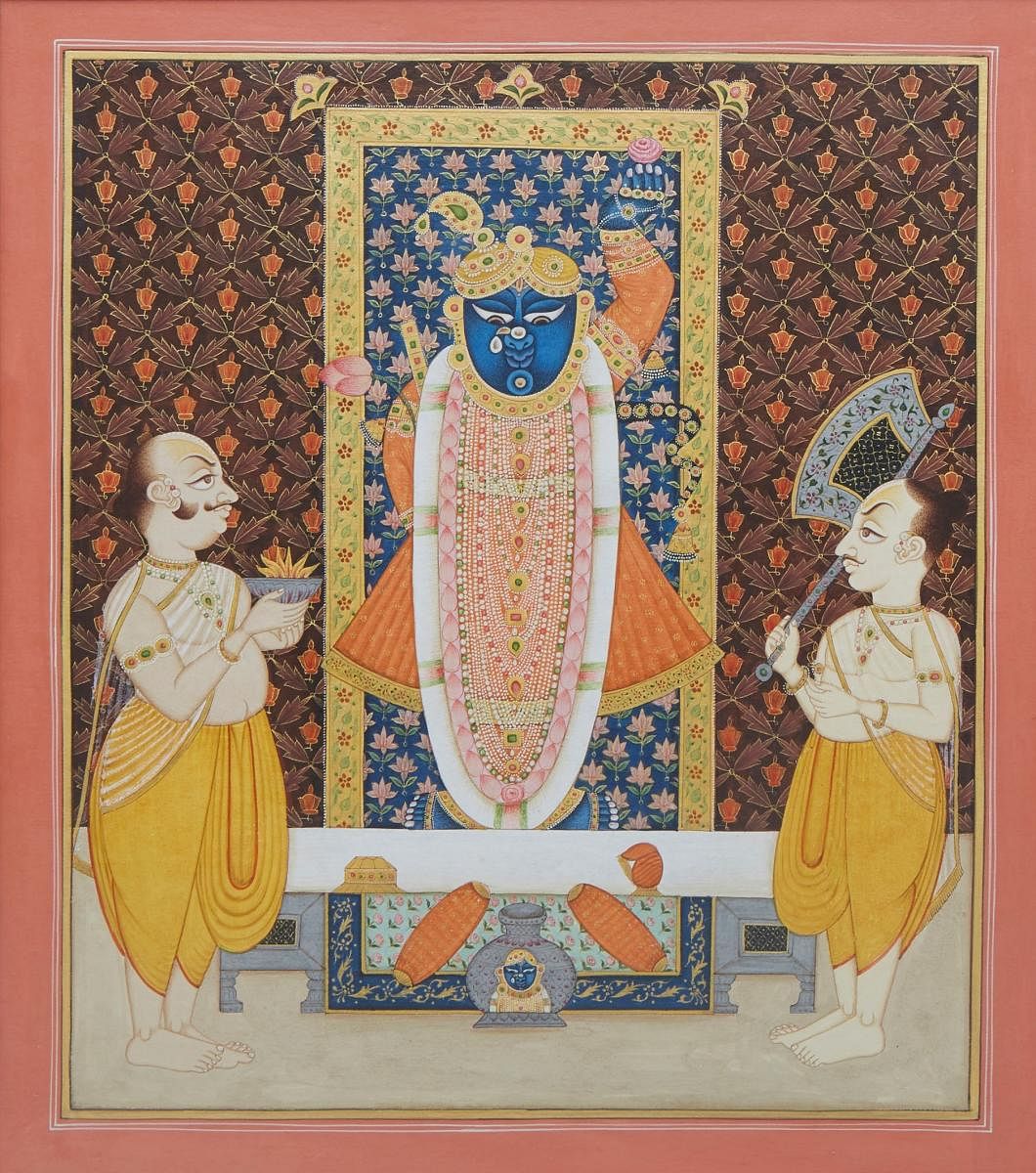
The main protagonists in Turkish author Orhan Pamuk’s exquisite work My Name is Red are miniaturists in the Ottoman empire. One of them calls a painting the “silence of thought and the music of sight.” He could well be talking about the breathtakingly intricate traditional art of pichvai that originates from a small temple town near Udaipur.
If you have been anywhere near Udaipur, you cannot miss the painted textiles and wall art featuring Lord Shrinathji, considered to be an incarnation of Lord Krishna and worshipped by a Vaishnavite sub-sect in the town of Nathdwara, famous for its Shrinathji shrine.
Originally, these textiles used to be hand-painted and hung behind the idol for ritualistic reasons. The paintings often depicted celebratory events in Lord Krishna’s life and featured the deity in vibrant looks and avatars. The main draw, was of course, the sophisticated detailing and the use of rich pigments and natural dyes. Slowly though, pichvai art gained recognition beyond its religious roots and seeped into wall art. Unfortunately, as it usually happens, the art itself then began descending into mediocrity, losing its patrons as well as its essence. Soon, it simply became yet another painting of Lord Krishna hanging in living rooms and obscure offices. Or a cheap souvenir of a Rajasthan trip lying forlorn on a dusty mantelpiece.
Infusing life
Pooja Singhal, who had grown up seeing and loving these works of art, felt a powerful urge, as she puts it, to stop this tragic descent and infuse new life into pichvai, its naturally pulsating colours and painstaking minutiae having made a permanent home in her heart. Originally hailing from Udaipur, Pooja is today a Delhi-based revivalist and curator who is almost single-handedly reviving the Pichvai art through her artistic, as well as marketing innovations. Pooja’s endeavour is two-fold — first up is the revival of the art form itself by experimenting with its colours, styles and sizes to entice genuine collectors and art-lovers; secondly, Pooja is looking to support the original Pichvai artists who are now, as can be expected, a fast dwindling community.
In fact, to keep the artists going as their sons and daughters are uninterested in continuing the profession, has been one of Pooja’s many challenges. “I started small. I initially worked with the scale of the paintings and got the artists to tweak little details, like for instance, the use of decorative Mughal motifs instead of traditional miniatures. It struck a chord with many, perhaps because the paintings, with their strong undercurrent of religiosity, gained a more diverse accessibility,” explains Pooja. Emboldened by the initial response, the revivalist dived deeper and attempted more avant-garde experimentations.
When she first started the project in 2009, Pooja, through her enterprise ‘Atelier: Tradition and Beyond’, wanted to convince contemporary art collectors that Pichvai could be an art form with an aesthetic that combines the best of tradition and modern art. The response kept building up, and in 2015, Pooja launched the ‘Pichvai: Tradition and Beyond’ series of art exhibitions at a colonial bungalow in Jor Bagh.
She later took the exhibits to wherever she could — from an ancient Chettinad house at the Kochi Biennale to the interiors of Famous Studios in Mumbai to the contemporary world of India Art Fairs.
In a new light
In taking her innovations a step further, Pooja is currently holding an exhibition of ‘Greyscale Pichvais’ in Bengaluru at Galleryske. “This is my most significant departure from the traditional form where we have decided to do away with the very vibrancy of colours that are intrinsic to pichvais and instead present them as monochromes or sketches,” she says.
Essentially, what Pooja has achieved is a complete deconstruction of the historical compositions. “Because of the heavy religious iconography in the traditional pichvais, many graphic details were being hidden or unnoticed. By giving them a greyscale, we are shining the light on so many other beautiful elements of a pichvai, which if you observe closely, are almost like parts of a maze with a surprise at every corner.”
The highlight of the greyscale exhibition is the ‘breaking up’ of a 400-year-old composition — an architectural map of a temple in traditional pichvai. “Not only have we re-interpreted this enormous map in greyscale but we have also ‘cut it up’ into different shapes and scales. The overall effect is that of pieces that fit with each other like a puzzle while also standing out as individual works of art,” says the curator.
Ultimately, the biggest achievement of this pichvai revivalism is not the contemporisation of the art form but the extracting of it from the grip of religious iconography. “With the removal of the focus on the idol, we are, in a sense, making the art works agnostic and something that can appeal to all. For instance, in some of the works, we have shifted the focus on the priests in various poses of salutation — they could be offering their prayers to Krishna, Christ or Allah. Or to no one.”
Now that sounds like a true revival, does it not?